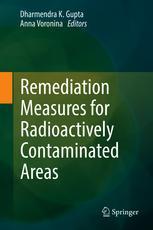Modelling the Effect of Mechanical Remediation on Dose Rates Above Radiocesium Contaminated Land
Published:

Abstract
Mechanical strategies for remediating radiocesium contaminated soils, e.g. at farms, schoolyards, gardens or parks, lower air dose rates in one of two characteristic ways. The first is to physically remove radiocesium from the environment, for example by stripping topsoil and sending it for disposal. The second is to redistribute the radiocesium deeper within the ground, e.g. by mixing the topsoil or switching the positions of different soil layers, in order that soil attenuates radiocesium gamma rays before they reach the surface. The amount that air dose rates reduce because of remediation can be calculated using radiation transport methods. This chapter summarizes modelling results for the effect of topsoil removal (with and without recovering with a clean soil layer), topsoil mixing, and soil layer interchange on dose rates. Using measurements of the depth profile of 134Cs and 137Cs activity in soil at un-remediated sites across North East Japan, the potential effectiveness of remediation work was estimated considering remediation to different soil depths and different time lags after the accident. The results show that remediation performance would have been essentially constant irrespective of the time at which it was undertaken in the initial five year period following the fallout.
A. Malins, H. Kurikami, A. Kitamura & M. Machida
Chapter 12, pp 259-272 of Remediation Measures for Radioactively Contaminated Areas (2019)
Editors: D. K. Gupta & A. Voronina
Published by Springer
Chapter DOI: 10.1007/978-3-319-73398-2_12
PDF: download
Book website: https://doi.org/10.1007/978-3-319-73398-2
ISBN: 9783319733975
